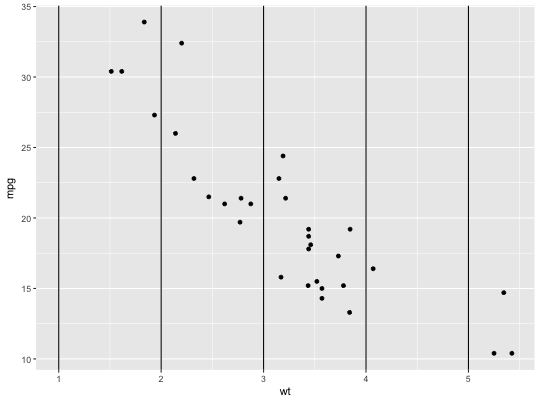Reference lines: horizontal, vertical, and diagonal
These geoms add reference lines (sometimes called rules) to a plot, either horizontal, vertical, or diagonal (specified by slope and intercept). These are useful for annotating plots.
geom_abline(mapping = NULL, data = NULL, ..., slope, intercept, na.rm = FALSE, show.legend = NA) geom_hline(mapping = NULL, data = NULL, ..., yintercept, na.rm = FALSE, show.legend = NA) geom_vline(mapping = NULL, data = NULL, ..., xintercept, na.rm = FALSE, show.legend = NA)
Arguments
| mapping | Set of aesthetic mappings created by |
|---|---|
| data | The data to be displayed in this layer. There are three options: If A A |
| ... | other arguments passed on to |
| na.rm | If |
| show.legend | logical. Should this layer be included in the legends?
|
| xintercept, yintercept, slope, intercept | Parameters that control the
position of the line. If these are set, |
Details
These geoms act slightly different to other geoms. You can supply the
parameters in two ways: either as arguments to the layer function,
or via aesthetics. If you use arguments, e.g.
geom_abline(intercept = 0, slope = 1), then behind the scenes
the geom makes a new data frame containing just the data you've supplied.
That means that the lines will be the same in all facets; if you want them
to vary across facets, construct the data frame yourself and use aesthetics.
Unlike most other geoms, these geoms do not inherit aesthetics from the plot default, because they do not understand x and y aesthetics which are commonly set in the plot. They also do not affect the x and y scales.
Aesthetics
These geoms are drawn using with geom_line so support the
same aesthetics: alpha, colour, linetype and
size. They also each have aesthetics that control the position of
the line:
geom_vline:xinterceptgeom_hline:yinterceptgeom_abline:slopeandintercept
See also
See geom_segment for a more general approach to
adding straight line segments to a plot.
Examples
p + geom_vline(xintercept = 1:5)p + geom_hline(yintercept = 20)p + geom_abline() # Can't see it - outside the range of the datap + geom_abline(intercept = 20)# Calculate slope and intercept of line of best fit coef(lm(mpg ~ wt, data = mtcars))#> (Intercept) wt #> 37.285126 -5.344472p + geom_abline(intercept = 37, slope = -5)# To show different lines in different facets, use aesthetics p <- ggplot(mtcars, aes(mpg, wt)) + geom_point() + facet_wrap(~ cyl) mean_wt <- data.frame(cyl = c(4, 6, 8), wt = c(2.28, 3.11, 4.00)) p + geom_hline(aes(yintercept = wt), mean_wt)# You can also control other aesthetics ggplot(mtcars, aes(mpg, wt, colour = wt)) + geom_point() + geom_hline(aes(yintercept = wt, colour = wt), mean_wt) + facet_wrap(~ cyl)








